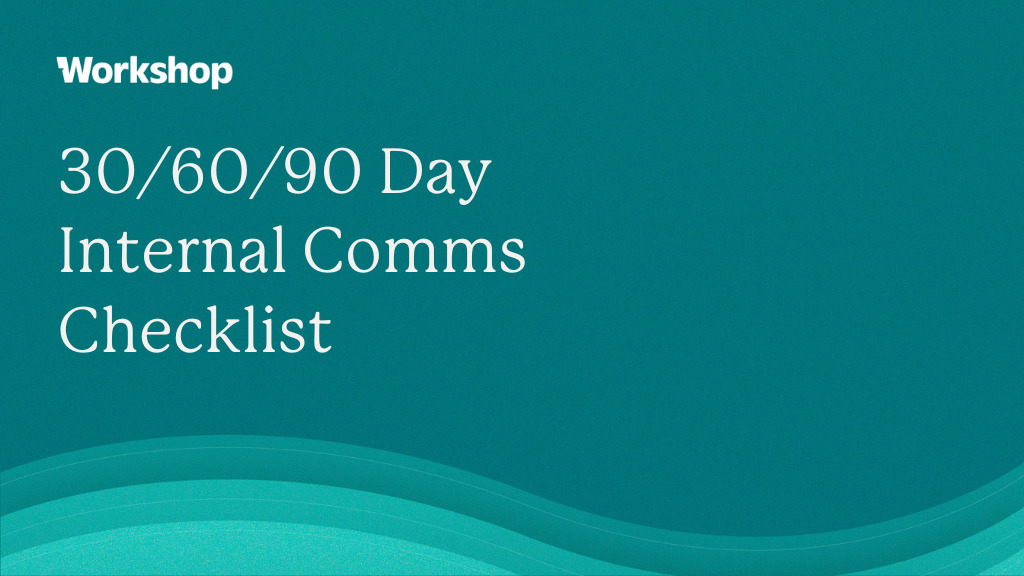A 30/60/90 plan example for internal communications

Here are our recommendations for a thorough 30-60-90 day plan in a new internal communications role. You can obviously use this for your first 90 days in a new job, but it’s also an amazing thing to bring to interviews and/or a really good option for a hard reset! Remember: your first 90 days are your first impressions. It’s an opportunity you may not get again, and it’s often a rare moment where you can be a bit high level before you have to dive into the day-to-day work. Use this chance wisely and structure your first few months for success!
We’ll start with an overview, and then dive into each piece into a bit more detail:
The first 30 days:
- Share your 30-60-90 day plan
- Understand the company’s current goals, priorities, & values
- Run an internal communications survey
- Start a listening tour
- Review the current toolset & processes
- Identify little wins
The first 60 days:
- Complete an internal communications audit
- Determine key metrics & set benchmarks
- Create an editorial calendar
- Set up monthly touchpoints with key stakeholders
- Achieve and showcase those little wins
The first 90 days:
- Document your internal communications strategy
- Publish a monthly report
- Evaluate new tools
- Advocate for resources (budget, team, etc.)
- Launch or revamp a few core internal communication campaigns
The first 30 days
In your first month of a new role, your number one goal is really just to listen and learn. You aren’t trying to implement a bunch of playbooks or processes…really, it’s about getting to know your colleagues, your company, and really just get a general lay of the land.
1.) Share your 30/60/90 day plan
This may seem a bit self-explanatory, but it’s a seriously valuable (and impressive) step! Simply share this plan with your boss and key stakeholders to help them understand what they can expect from you in the first few months of the role. It’s a really quick way to actually implement your own “internal communications” and ensure that everybody is on the same page.
2.) Understand the company’s current goals, priorities, & values
You play a crucial role in helping employees understand and align with company goals, priorities, and values. Take this first month to really dive into the organization’s mission and values, and demonstrate a real commitment to the company’s mission. Ask questions about the company’s priorities, and align your communication strategy accordingly. This way, you’re positioning yourself as a strategic partner right from the beginning.
3. ) Run an internal communications survey
Let’s get some quantitative data straight out of the gate! Sending out an internal comms survey is also a great way to get a view on what is or isn’t working in the company’s current internal comms strategy. This will give you a good benchmark to start with and a way to measure your efforts over time.
We recommend asking a mix of scaling and open-ended questions, such as:
- How happy are you with the overall internal communication you currently receive?
- What information do you wish you had more of?
- What information do you wish you had less of?
We have an internal communications survey template you can download here!
4.) Start a listening tour
This is a great time to begin a few qualitative interviews, as well. You’re looking to audit the current state of internal communications and really get a sense of the baseline. (I often structure these as a start/stop/continue).
A few things to keep in mind:
- Choose a diverse audience! Select employees from different departments, roles, locations, with different levels of seniority, tenure, backgrounds, etc.
- Include key stakeholders 😉
- Use 1-on-1 interviews or small focus groups (8-10)
- Prepare open-ended questions to guide the discussions
Make sure you’re doing informal listening, as well (basically, lurking)! Be everywhere your employees are and just listen. In the office, try to keep out for those “watercooler”-type conversations. When evaluating pre-existing communication channels, look for the most and least popular posts and see if you can determine trends or patterns. And be sure to find out if there are private channels or other channels that employees are using to communicate!
5.) Review the current toolset & processes
Create a list of all the internal communication tools and platforms currently in use. Evaluate each tool’s purpose, functionality, and user adoption.
A few other things you’re looking for:
- What are the pain points with the current tools?
- Is there training and documentation on these tools?
- What department owns the tool? And/or budget?
- Where do communication requests come from?
- Are your internal communications proactive or reactive?
- Do you have easy ways to collect feedback?
6.) Identify little wins
Look for ways to make a quick impact with as few resources as possible (time, money, energy, etc.)
A few of our favorites to recommend:
- Implement Q&A at all-hands meetings
- Add merge tags to internal emails & don’t send them from a “catchall”
- Send a welcome email introducing yourself to the team
- Create a mini-campaign to highlight a recent win that you weren’t a part of
- Create a communications request form and/or streamline requests
The first 60 days
In your first month of a new role, your number one goal is really just to listen and learn. You aren’t trying to implement a bunch of playbooks or processes…really, it’s about getting to know your colleagues, your company, and really just get a general lay of the land.
1. ) Complete an internal communications audit
We know this can seem like an overwhelming task! Typically, we break down an internal communication audit into seven key steps. (You can find our complete guide here! It will walk you through how to run an audit from start to finish.)
Luckily, you’ve already done a TON of the work in your first 30 days, and a lot of what you need to do now is just review all of your data, put together an action plan, publish a report, and share your insights. This is an incredible way to get the buy-in you need from senior leadership, as well!
Here are a few common areas to focus your audit and action plan:
- Channel effectiveness
- Communication preferences
- Cross-department communication
- Approval process
- Executive communication
- Employee awareness and recall
- Resource availability and bottlenecks
2. ) Determine key metrics & set benchmarks
We always start our initial focus on email because everyone has it in one way or another. It’s consistently ranked the #1 channel for internal comms, in many times regardless of generation or industry.
Whether or not you have access to these metrics is based on your tools, but here is a good overview:
- Email: Open rate, click-through rate, mobile usage, time read, metrics by department/role/location, survey data, campaign analytics (Want all of these metrics? Take a look at Workshop’s internal email platform!)
- Intranet: Login numbers, usage time, traffic, clicks, top posts, most-commented posts
- Slack: Weekly active messages, how many messages were read in public channels, private channels, and direct messages; active members, change in active members
- SMS: Opens, clicks
- Zoom/video: Attendance
- 1-on-1s: Frequency, attendance
Our advice for all internal communications metrics (and marketing metrics, and engagement metrics, and really any metrics for that matter) is this: benchmark against yourself.
By this, we mean that you should make sure you are setting your own benchmark, and not necessarily using industry standards/Googling for an average open rate for internal communications. There are many reasons for this, but for starters, you don’t want to set an unrealistic goal for yourself. If your organization has an internal email open rate of 30%, it’s not going to be feasible for you to try to hit 70-80% (which is the average open rate we see across our 200+ customers). And open rates can vary widely across industries, employee sizes, locations, etc., and you could be chasing a metric that you may not realistically reach.
3.) Create an editorial calendar
This is one that won’t take a ton of time to put together, but it’s a fantastic deliverable and it will save you hours and hours of stress in the future. Rather than spending time every single month researching holidays, observances, and other event dates, put together your internal communications editorial calendar now. (Be sure to check with the company, too, to discover if they have their own internal events or key deadlines — like open enrollment, holiday parties, the company anniversary, etc.)
We actually have an internal communications editorial calendar that you can use as a template. This calendar will help stay on top of important deadlines, ensure consistency in your messaging, and make the most of your time. We’ve also pre-filled it with common holidays and observances to give you a great head start!
4.) Set up monthly touchpoints with key stakeholders
Meeting with key stakeholders is a proactive and strategic approach that enhances the effectiveness of yourinternal communication efforts, fosters collaboration, and makes sure everyone is on the same page. Whether it’s quarterly, monthly, or bi-weekly, make sure you have the following departments on your side early: HR, IT, marketing, and the leadership team.
5.) Achieve and showcase those little wins
Now is the time to execute on all of the little wins you identified last month! Launch those small initiatives, and then create a “smile file” to keep screenshots of DMs or email replies that are praising those efforts or just saying nice things. Be sure to share those with leadership or in public channels to celebrate!
The first 90 days
In your first month of a new role, your number one goal is really just to listen and learn. You aren’t trying to implement a bunch of playbooks or processes…really, it’s about getting to know your colleagues, your company, and really just get a general lay of the land.
1.) Document your internal communications strategy
It’s time to create a comprehensive internal communication strategy document! You’ve done all the work for this, and now you get to put all of your research together and feel REALLY good about the future of your department. Start by defining clear goals that you can directly achieve (we have a list of common KPIs to choose from here)! Then, build out a multi-channel strategy that’s designed to reach 100% of your employees. Finally, make sure that your campaigns and major efforts are incorporating everything that you’ve learned from the survey, audit, listening tour, etc.
- Define clear goals using metrics that you can directly achieve.
- Create a multi-channel strategy designed to reach 100% of your employees.
- Incorporate everything that you’ve learned from the survey, audit, listening tour, etc.
2.) Publish a monthly report
Tracking metrics helps the leadership team understand the value and impact of your internal communications initiatives and efforts.
Generating a monthly report is a great way to help compile your internal comms efforts, successes, opportunities, and key metrics so you can present a nicely organized report (and showcase the value of your internal comms efforts!) to key stakeholders and leadership.
Things we like to include:
- A summary of your overall performance
- Quick details about how the team is performing on its current goals
- Sharing 3-4 of your best performing emails or intranet posts — your slam dunks!
- A story about your gold medal winner for the month – your highest performing internal communications of the month
- A table that showcases your KPIs (For example, if your KPI is Internal Emails Sent, list out the target versus what was actually sent)
- And a section that details your opportunities — something the team is focusing on for the next month!
Here’s a template for an internal communications report!
3.) Evaluate new tools
Make sure that you have the tools you need to create, send, manage, and measure the internal communications strategy you’ve outlined. At a minimum, there are four tools that we recommend as a part of every internal communications tech stack.
- Email = primary method
- Text = great for frontline / desk-less employees
- Intranet = archival / asynchronous
- Slack/Teams = mobile-first generation
We dive into all four of these options in-depth in this article. Also, make sure your tools evolve! They should suit YOUR workflow and be able to deliver on the needs of YOUR audience. They should be tools that are improving over time, and not archaic software that needs a bunch of internal support to keep maintained.
4.) Advocate for resources
This is your time to make the big asks for the budget and resources you need! You’ve been building buy-in and you’ve laid out an incredibly compelling strategy. So be sure that your budget is set up to support that in a really reasonable way that’s fully aligned with the business goals. Your budget should encompass program costs, new hires, and the necessary toolset.
You can also explore unconventional approaches, such as requesting a portion of the marketing budget for internal marketing. You could also help the team audit existing spending and reallocate funds strategically to align with your goals!
5.) Launch or revamp a few core internal communication campaigns
Spice up a few old campaigns (or launch new ones)!
We recommend the following because they’re the most impactful:
- A monthly newsletter
- An all-hands meeting recap
- A weekly CEO email
These tend to be the most “expensive” emails (in theory) because they go out to the entire organization. If these don’t fit, simply prioritize 1-3 emails that are sent to the entire staff list.
The only 4 internal communications tools you need
If you’re getting settled in your new role, one of the first places to look is at your internal communications tech stack. Here are the only four internal communications tools you need in 2024!








